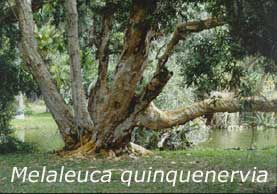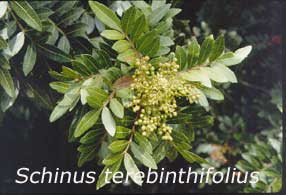Home > Tree selection > Invasive plants
Invasive Plants
 Invasive
exotic plants (also known as noxious weeds) are those non-native
species that are disrupting naturally occurring native plant communities.
Some plants may exhibit rampant growth and rapid dispersal when
introduced outside of their native habitat where weather and soil
conditions, feeding by herbivores, and pests and diseases keep them
under control. Invasive exotic plants out-compete and displace native
species, disrupt the ecology of the natural community (by affecting
the other plants and animals which are dependent on the displaced
species), and alter natural processes such as fire and water flow.
Invasive
exotic plants (also known as noxious weeds) are those non-native
species that are disrupting naturally occurring native plant communities.
Some plants may exhibit rampant growth and rapid dispersal when
introduced outside of their native habitat where weather and soil
conditions, feeding by herbivores, and pests and diseases keep them
under control. Invasive exotic plants out-compete and displace native
species, disrupt the ecology of the natural community (by affecting
the other plants and animals which are dependent on the displaced
species), and alter natural processes such as fire and water flow.
Some of the best-known examples in Florida are the Brazilian pepper (Schinus terebinthifolius) and melaleuca (Melaleuca quinquenervia), both of which have formed dense thickets occupying hundreds of thousands of acres in the southern part of the state. This has resulted in the destruction of native plant communities, loss of habitat for endangered native species, and the reduction of wetlands. Camphor tree (Cinnamomum camphora), mimosa (Albizia julibrissin), and Chinese tallow tree (Sapium sebiferum) are among the most common invasive trees in northern Florida.
 Potential
invasivity should be considered when selecting trees for the landscape.
It is against the law to possess, move, or release any plant pest
or noxious weed regulated by the Florida Department of Agriculture
and Consumer Services and the United States Department of Agriculture
except under permit. Lists of invasive trees, shrubs, and herbaceous
plants are maintained by various national and state agencies and
organizations.
Potential
invasivity should be considered when selecting trees for the landscape.
It is against the law to possess, move, or release any plant pest
or noxious weed regulated by the Florida Department of Agriculture
and Consumer Services and the United States Department of Agriculture
except under permit. Lists of invasive trees, shrubs, and herbaceous
plants are maintained by various national and state agencies and
organizations.
State listings may be accessed at both the USDA Natural
Resources Conservation Service Invasive Plants Database and National
Invasive Species Council website. In Florida, the best sources for
information are the Florida Exotic Pest Plant Council (FLEPPC) and
the University of Florida Center for Aquatic and Invasive Plants.

